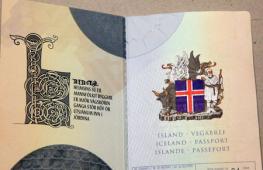New rules of entry and location in Schengen countries
The rule of the first entry into Schengen in 2019 establishes a special order of crossing the border after receiving a visa. It is assumed that you should enter the country where you received permission to enter, although Schengen gives the right to move throughout all 26 countries of the Schengen zone. After crossing the border there are no restrictions, you can travel throughout the EU area and leave any place convenient for you.
The new Visa Code of the EU does not contain references to the rule of the first entrance. It did not contain similar information and in its old version. However, this does not mean that the rule of the first entrance to the Schengen visa is canceled.
It works only when it is impossible to determine the country of preferential stay - if you planned an active journey through many European countries. As a general rule, the stamp to the passport is obtained in the consulate of the country where more time is planned.
If the permission for the entry was not used (for example, you made it in Slovakia, but went to Italy), then the second appeal to the Slovakian embassy for a visa could lead to failure. In the case of a multiple visa, your number of border crossings into the country where you were issued should be more than in all other Schengen countries.
These are unlawful rules that use all European embassies without exception. Thus, the first country of entry through a Schengen visa is still important, although no one has the right to refuse you in the entrance through another EU country. For example, if you make a one-time visa to one country, and your return tickets from the other and the reservation of the hotel confirms that you will be resting in a different place, it can even lead to right on the border.
The Cancellation of Multivibuses occurs only in emergency cases, for example, if you are not able to explain the purpose of the trip, the reason for entry through the other and generally call suspicion of the border guards with the author's answers to questions.
What is the first entry rule
The first entrance to the Schengen visa is the intersection of the country's border, where the permission is made to enter. The fact is that when submitting documents for receiving a stamp, you fill out a questionnaire sheet and specify your EU route. Violation of this route is not a crime or reason to cancel the stamp in the passport. However, you must be able to explain why you decide to change your plans if border guards ask you about it.
You can use as arguments:
- discounts for air tickets and the opportunity to save on a trip;
- proof of the future accommodation in the state where permission to enter (for example, hotel reservation);
- other explanations of the transit to the place of stay.
The country of the first entrance to the Schengen during transit may differ from that, the visa of which is decorated if you are heading into it. Especially often such violations are occurred at bus and road trips, when, for example, in France or Italy go through Austria or Hungary.
The new Visa Code of the EU canceled the transit visa "B". Now you make out usual Schengen to the state that intend to visit, but in their questionnaire, you must indicate through what states you are transit.
Passing the border without problems: video
The rule of the main country stay
The main country rule Schengen implies that you must count the days you spent there in other states. Accordingly, it is desirable to plan your route so that in the main country you can stay longer.
This requirement is not tough and not a fact that in the case of re-registration of Shengen, someone will adhere to what you stayed for 2 days more than it followed. Basically pay attention to situations where the visa was drawn up with a dubious goal - staying in a completely different country. For example, a visa to Italy requires serious financial guarantees for every day of stay (at least 70-100 euros per day). If you decide not to burden yourself with problems and issued a visa at the Greek Embassy, \u200b\u200bwhere it is much easier and financial requirements below, then it may look like a kind of visa fraud.
The rules of their stay on a Schengen visa are aimed at that such cases be less. In addition, if you go to the tour on your own, it is meant that at the stage of receiving a single visa you should be booked hotels. If the tourist easily violates his obligations and settles completely in another country, then he must have good reasons for this.
Cancellation is not the only problem that may arise in this case. Even if you do not cross the visa in the passport, next time you can get if not a failure, then a shorter visa than that you claimed.
Standard time set in the Schengen zone

Recently, short visas (for a month) give out more and less. Mostly tourists receive a visa for 90 days in the half year. The first time the Schengen visa is issued for how many days, tourists often ask. Usually for 30-90 days. The rules of entry and departure to the Schengen zone imply that from this number of days, for example, three months should be held most of the time in the country that spent time on the study of your documents and the issuance of a visa.
- consulate;
- diplomatic confinement;
- visa Center;
- house or office (if you order a mobile biometry).

Without passing the data, it is impossible to qualify for a Schengen visa. All information gets into a single Base of Vis, which is open to European border services. New rules oblige consulates to always provide a written refusal to indicate the cause (lack of documents, fictitious information, etc.).
Children are released from biometric data to 12 years. New rules also provide for the responsibility of a visa applicant to personally apply for a questionnaire and a package of documents for a visa, and to do it only in the country where he lives. Thus, you cannot extend visas in the EU, for this you will need to return to Russia again (if it comes to national resolution D). Exceptions are possible only in the case of force majeure (earthquake, terrorist attack).
Innovations are connected with the tougher regulations of the work of consulates. They must put visas to the maximum within 10 days, and if it is required to pass an interview (for example, for an educational or work visa), it is obliged to assign a date no later than 14 days after the appeal. The presence of biometric data in the Base VIS allows you to instantly identify a person, so that visa control itself is accelerated.
Special agreements between countries
Belgium, Sweden, the Netherlands and Luxembourg agreed among themselves that in them the rule of the first entrance is not valid. If you enter through these countries, there will be no problems.
Which loyally belong to the changing route to tourists also exists. However, it is not official, so it is still not worth sticking to it. In order not to provoke a waiver in a visa in the future or at all to disrupt the trip due to the cancellation of the stamp in the passport, it is better not to break the rule of the first entrance when making a single visa. The exception is only the above-described countries.



